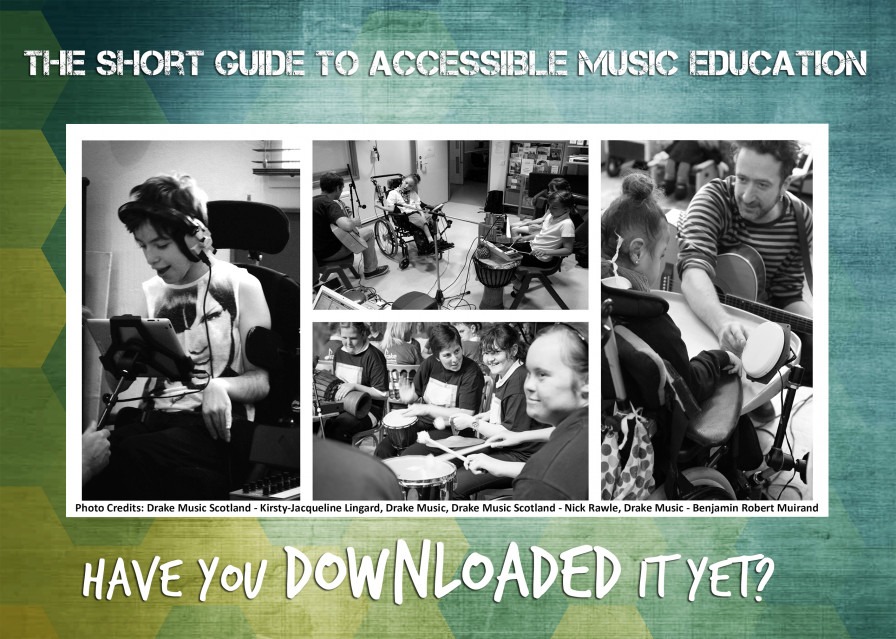The Short Guide to Accessible Music Education (NEW resource)

Inclusive music making is often wonderfully complex, but sharing the knowledge should be simple.
Last year, a music teacher from a special school approached me after a conference presentation to ask a question: "Can you give me a list of what music equipment I need to buy?" As he stood there patiently, pen hovering, waiting for a reply, I was sorely tempted to help by reeling off a list of ubiquitous items.
But the boring truth is, it's a tad more complicated than that. And it all depends. And even if you did buy some equipment, the kids haven't read your list. They might need or want something completely different. And something different again if it's a Tuesday in June.
My teacher's enquiry was wholly pragmatic and reflects a common impulse amongst many staff, particularly non-specialists, to find out 'what works, what to buy and how to get on with it' when it comes to music and ASN/ SEN/D. Most people understand there is not a 'silver bullet' for success.
But surely, we can pin down some principles, share resources and swap experiences more readily than it’s currently possible to do? People regularly tell us it would be great to have such a resource.
Welcome, then, to The Short Guide to Accessible Music Education (UK), a new resource created by Jonathan Westrup (Music Education manager, Drake Music), Emma Lines (Senior Programme Manager, Drake Music Scotland) and the Music Education Council’s ASN/ SEN/D Focus Group.
You can download the guide from February 10th by clicking here
Much as we are excited about this new resource, we also feel compelled to get some important disclaimers out of the way:
1. Our focus is on children and young people with ASN/ SEN/D and music education. It would be wonderful to open the guide up wider but ultimately, we could be swamped by content.
We’ve used the term ‘accessible music education’ because ‘ASN/ SEN/D music education sector’ is really a construct, used as short hand. What we’re aiming to promote are approaches and attitudes which open up music to people who face barriers to participating.
2. This guide represents the things that we are aware of at this given moment in time. We 100% acknowledge there's a whole load of stuff out there we have missed out and we wholeheartedly apologise to those people now.
Remember the famous scene in Blackadder where Samuel Johnson has to keep making additions to his ‘finished’ English Dictionary as Blackadder suggests new words? Well, that’s going to be us for the next few months. So…
3. …please get in touch and let us know if we’ve missed you out! – that’s partly the point of the exercise, to publicise what we already know and then shine a spotlight on things that may be more hidden, but equally great.
4. We are only signposting, not offering opinions or value judgements.
5. We will be monitoring how many hits we get in the first year to see if this is a resource worth scaling up and developing further.
So, what is the Guide?
In this first edition, it comes in the form of a downloadable pdf with hyperlinks to each entry. We wanted to keep things simple at this stage, just a button you press to download the resource.
What you’ll see is a list of contents covering:
- Music organisations and music charities
- Teaching and Learning
- Instruments and Ensembles
- Professional Development
- Social Media
- Accessible music venues and performances
Alongside all this information, we acknowledge that some people are more comfortable with 'pinning this stuff down' than others.
A quick anecdote: I was once part of a duo tasked with creating training courses for inclusive music making and then training a group of practitioners on using it. A little way into the session, there were a lot of hands going up and slightly puzzled faces. We soon realised that, for a significant portion of the audience, the idea of translating their experiences and approaches into a training 'package' felt a bit alien, even counter-intuitive. It took my colleague and I slightly by surprise, as we'd reckoned on the session having been clearly advertised!
But herein lies the conundrum of ‘teaching’ inclusive music making: how to capture and disseminate approaches that are often very fluid, and can look and feel different when replicated in a variety of places and contexts.
It can also be highly personal with many musicians building up a body of professional experiences and teaching resources in this area which are singular and inexorably linked to that journey. How to turn that into something that many could relate to and replicate?
Hopefully, our Guide will make a small contribution to bridging this gap.
Ultimately, we think our criteria for success is threefold:
- Downloads – we want as many as possible!
- Debate – we want the guide to act as a catalyst for discussion.
- Disseminate – we want the information to reach people across the UK and increase the opportunities for disabled children and young people to participate in music education.
Emma Lines and I will be launching the Guide at the Music and Drama Education Expo in London on Friday February 10th. Please come and find us at the Sharing Lab/ Teachmeet zone at 1pm.
